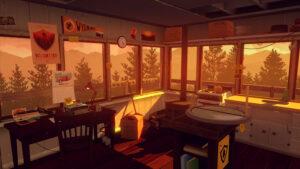Firewatch is a walking simulator game by the developer studio Camp Santo. The game, which is perfect for teens and young adults that enjoy the outdoors, follows a main character, Henry, as he begins a job as a Wildfire Lookout in a Wyoming national forest. Like many walking simulator games, it questions the mainstream notions of games as mastery. Firewatch specifically uses walking as a mechanic for uncovering resources that can either convey narrative information or provide an opportunity for the player to present oneself as the character. The combination of these resources, which can be discovered by walking, generates an emergent narrative for players and allows players to embrace this narrative to the extent that they are comfortable with.
I played Firewatch for two in-game days. The game began with a backstory of the main character, Henry, and his relationship with his wife, who has dementia. After this introduction, we are placed into the point of view of Henry, who is just beginning his job in the Wyoming wilderness. Although the backstory presented at the beginning of this game was very emotional and immediately connected me, as a player, to the character Henry, embodying Henry in the walking simulator at this point in the game made me feel as if I was really a part of this game. The game gives you many small resources that you can interact with that are ultimately useless, but present an emotional connection to the character Henry. For example, there’s a picture of Henry and his wife in the Lookout tower. The player can pick this up and examine it, even though doing so does not help complete the task at hand. You can see some of these “useless” resources in the image of Henry’s lookout below. Regardless of this, while playing, I still found myself picking up this picture. Because I had the freedom to walk around and find this artifact, I had more space to ask the question “What would Henry do?” and Henry would pick up the picture and look at it. Moments like this were more emotional to me than reading the initial backstory because I, as the player, have the responsibility of moving Henry around the space in a manner that best fits his character.

Similarly, beyond just acting as a means of character embodiment, the walking and interacting mechanics of Firewatch allow players to uncover information about the narrative of the current space. Again, this is very related to the principle of unusable resources, but when trying to understand the narrative of the space, these resources take on more of the role of “Chekhov’s gun.” Although I didn’t get far enough into this game to fully test this, many of the resources I encountered seemed placed strategically to get me, as the player, thinking about how they will be used in the grand scheme of the game’s narrative. As an example, when I encountered the pulley system between my lookout and Delilah’s, Delilah gave a very suspicious response about the system not being used very often. I immediately knew that the pulley system would be important to the narrative later on in gameplay. By having the agency to walk around and explore the space of the game myself, I am able to foreshadow future narrative events. Even beyond foreshadowing these events, clues such as these can help players understand the narratives with varying depth. While playing, I found a missing person sign in a supply box. Had I not walked to and discovered that box, I would have missed out on the narrative element that enhances the suspense and intrigue of Firewatch’s narrative.
Overall, Firewatch uses its walking simulator structure to let players get what they put into the story. If they want to spend time exploring every detail and fully acting in the way that Henry would, they will fully embrace the narrative of the game’s storyline. However, if they want to complete the game as fast as possible and not explore, they can also do that. They will be missing out on much of the game’s intended narrative though.
Images from https://www.firewatchgame.com/.



